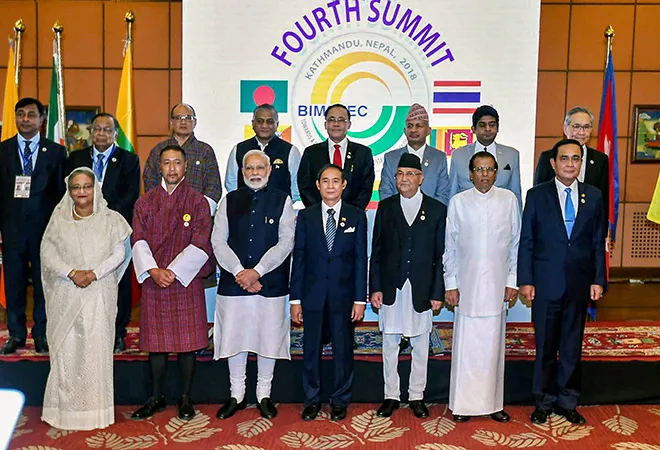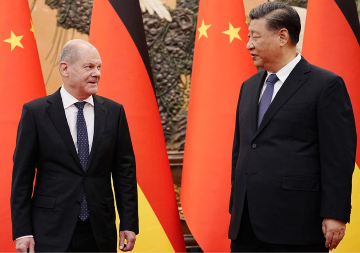
Ahead of the BIMSTEC Summit in Nepal, New Delhi would do well to take stock of its integration and development initiatives around the sub-continent. The fact remains that BIMSTEC, along with other regional initiatives such as the South Asian Association for Regional Cooperation (SAARC) and the Bangladesh, China, India and Myanmar Economic Cooperation (BCIM-EC), has remained dysfunctional. Consequently, the intra-regional trade in South Asia has been abysmally low with Indian regional leadership being the principal collateral.
The only initiative with that appears to have shown some promise so far is the Bangladesh, Bhutan, India and Nepal (BBIN) initiative, which signed a historic Motor Vehicle Agreement (MVA) in 2015, signaling a resurgence of ‘sub-regions’ as key loci for regional integration. India has spent a fair amount of diplomatic and investment capital in enabling the MVA. At present intra-regional trade accounts for only five per cent of total trade, according to a World Bank study — a reminder of why individual countries in South Asia are turning to China as a reliable trade partner instead. On the other hand, this trade is likely to increase by 117 per cent from the current USD 23 billion if transport connectivity is strengthened and cross-border trade facilitation improved.
Indeed, the economic potential that is born from of integrating just three states, who are all a part of the BIMSTEC, should suggest the possibilities of a more articulate and expansive regional connectivity agenda. If India wants BIMSTEC to emerge as an important forum for regional integration, the success of the BBIN will go a long way towards displaying intent and capability. As Prime Minister Modi prepares to signal India’s leadership role in Kathmandu, an analysis of India’s role in the MVA process will prove instructive on the positive consequences of demonstrable Indian leadership and the costs of lost momentum.
First, India needs to demonstrate leadership in regional connectivity through consistent execution. The Prime Minister’s reset of relations with Nepal in May is crucial to understand India's re-orientation of regional outreach at a time when Beijing's Belt and Road Initiative is upending strategic equations across the continent. Nepal, vital to South Asian stability, stands to benefit the most from the BBIN and BIMSTEC connectivity projects. It secures access to its nearest ports and would be able to export Nepalese goods even beyond the region. The example of Nepal goes to show that if India can get the vehicles to move across borders, the reliance on Chinese built ports and infrastructure will reduce; and India can then replicate such initiatives with other BIMSTEC states such as Bangladesh, Myanmar and Thailand.
India needs to demonstrate leadership in regional connectivity through consistent execution.
It was unfortunate, then, that administrative hurdles from India’s bureaucracy have once again delayed the process. The protocol for passenger and cargo movement under the MVA were reviewed for the past two years, with the former being concluded at the last meeting in April 2018. Unfortunately, the Indian government decided to hold up finalising the passenger protocol until the cargo protocol is negotiated, which would take several further rounds of negotiations. While New Delhi's reasons for doing so are unknown, the implications are clear — the agreement loses all forward momentum.
To add to the confusion, at about the same time the Indian government circulated a ‘letter of exchange’ to Nepal and Bangladesh to sign the three-country implementation of the MVA; and to Bhutan to counter-sign it. The signing of this additional agreement will go through another round of approvals. A further delay is not difficult to anticipate.
These delays are representative of India’s often messy regionalism. Just like the MVA, the cost of delaying the regional integration through the BIMSTEC is economically and politically high. The positives are equally great: BIMSTEC and the MVA allow New Delhi to tie up the loose ends of its ‘Act East’ and ‘Neighborhood First’ policy.
Which leads to the second point: if the BBIN is successfully executed, India has a replicable model to make BIMSTEC work. At present, BIMSTEC is in the doldrums, lacking sufficient commitment from Thailand, Sri Lanka and Bhutan. The ‘demonstration effect’ of well-functioning road connectivity between the three-nation BBIN bloc would catalyse the desired level of cooperation among the BIMSTEC countries. In a post-BRI world, reliance on Chinese-built ports and infrastructure will grow. For India, a way to preserve the arteries of sub-regionalism is essential, and BBIN represents a seed for that alternative. Building on the BBIN platform, India must be willing to commit significant financial, human and technical resources to strengthen BIMSTEC.
If the BBIN is successfully executed, India has a replicable model to make BIMSTEC work.
Third, the private sector needs to be represented more prominently in BIMSTEC. Perhaps the most glaring oversight of the BBIN was India’s failure to involve the private sector in its regional initiatives. The trial run along Kolkata-Dhaka-Agartala and Delhi-Kolkata-Dhaka routes alone, for example, reported cost savings of about 20 per cent alongside a substantial reduction in travel time. The benefits of BBIN connectivity then, would extend to the growth of micro, small and medium enterprises in all three nations, the building of regional value chains, and advancing innovation and entrepreneurship. New Delhi must realise that adequate representation from the private sector during negotiations would bring to the forefront those operational issues that are relevant to companies’ logistical need — which would make the MVA, and by extension connectivity initiatives under the BIMSTEC, truly transformational.
India must lead the integration process in South Asia if it is to retain its economic and political significance in the region. For this to happen, New Delhi must reassess its internal decision-making machinery and processes. The unnecessary delays in implementing the MVA were self-inflicted wounds — something Delhi must avoid as it prepares to take on a larger role in the BIMSTEC. Just like the BBIN MVA, the BIMSTEC is a strategic, economic and socio-political opportunity for India to recalibrate its imperfect relationship with the neighbouring countries. The Prime Minister’s Office must step in to re-energise Indian leadership on regional connectivity and deliver on one of the PM’s key ambitions.
The views expressed above belong to the author(s). ORF research and analyses now available on Telegram! Click here to access our curated content — blogs, longforms and interviews.




 PREV
PREV


